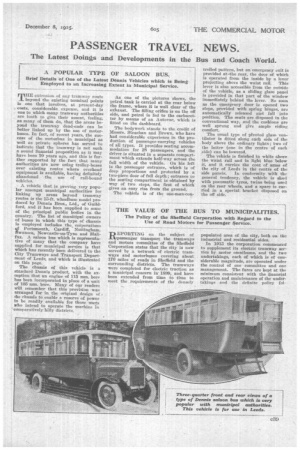A POPULAR TYPE OF SALOON BUS.
Page 23

If you've noticed an error in this article please click here to report it so we can fix it.
Brief Details of One of the Latest Dennis Vehicles which Is Being Employed to an Increasing Extent in Municipal Service.
MHE extension of any tramway route
beyond the existing terminal points is one that involves, at present-day . costs, considerable expense, and it is one to which many tramway authorities are loath to give their assent, feeling, as many of them do, that the areas beyond the tramway dead-ends can be better linked up by the use of motorbuses. In fact, of recent years, the success of the motorbus in municipal as well as private spheres has served to indicate that the tramway is not such a sound financial proposition as it may have been 10 years ago, and this is further supported by the fact that many authorities are now using trolley-buses over existing routes where overhead equipment is available, having definitely abandoned the use of rail-bound vehicles.
A vehicle that is proving very popular amongst municipal authorities for linking up areas beyond tramway routes is the 15-ft. wheelbase model produced by Dennis Bros., Ltd., of Guildford, and it has been supplied to some of the principal public bodies in the country. The list of municipal owners of buses in which this type of chassis is employed includes the coiporations of Portsmouth, Cardiff, Nottingham. Swansea, Newcastle-on-Tyne and Halifax. A saloon bus which is representative of many that the company have supplied for municipal service is that which has recently been delivered to the City Tramways and Transport Department of Leeds, and which is illustrated on this page.
The chassis of this vehicle is a standard Dennis product, with the exception that an engine of 115 mm. bore has been incorporated in place of a unit of 105 tom. bore. Many of our readers will remember that this provision was arranged for in the original design at. the chassis to enable a reserve of power to be readily available for those users who intend to operate the machine in comparatively hilly districts. As one of the pictures shows, the petrol tank is carried at the rear below the frame, where it is well clear of the exhaust. The filling orifice is on the off side, and petrol is fed to the carburetter by means of an Autovac, which is fitted on the dashboard.
The bodywork stands to the credit of Messrs. Strachan and Brown, who have had considerable experience in the production of passenger-carrying vehicles of all tYpes. It provides seating accommodation for 28 passengers, and the driver is situated in a separate compartment which extends half-way across the full width of the vehicle. On his left is the passenger entrance, which is of deep -proportions and protected by a two-piece door of full depth ; entrance to the seating compartment is obtained by way of two steps, the first of which gives an easy rise from the ground.
The vehicle is of the one-man-con trolled pattern, but an emergency exit is provided at-the rear, the door of which is operated from the inside by a lever projecting above the waist rail. This lever is also accessible from the outside of the vehicle, as a sliding glass Panel is provided in that part of the window immediately behind the lever. So soon as the emergency door is opened two steps, provided with spring hinges, are automatically released and fall into position. The seats are disposed in the conventional way, and the cushions are well sprung and give ample riding comfort.
The usual type of pivoted glass ventilator is fitted along each side of the body above the ordinary lights; two of the latter (one in the centre of each side) can be lowered.
The vehicle is finished in Nvbite above the waist rail and in light blue below it, and it carries the coat of arms of the city of Leeds in the eentre of the
side panels. In conformity with the general tendency, the vehicle is shod with pneumatic tyres, twins being used on the rear wheels, and a spare is carried in a special bracket disposed on the off, side.
































